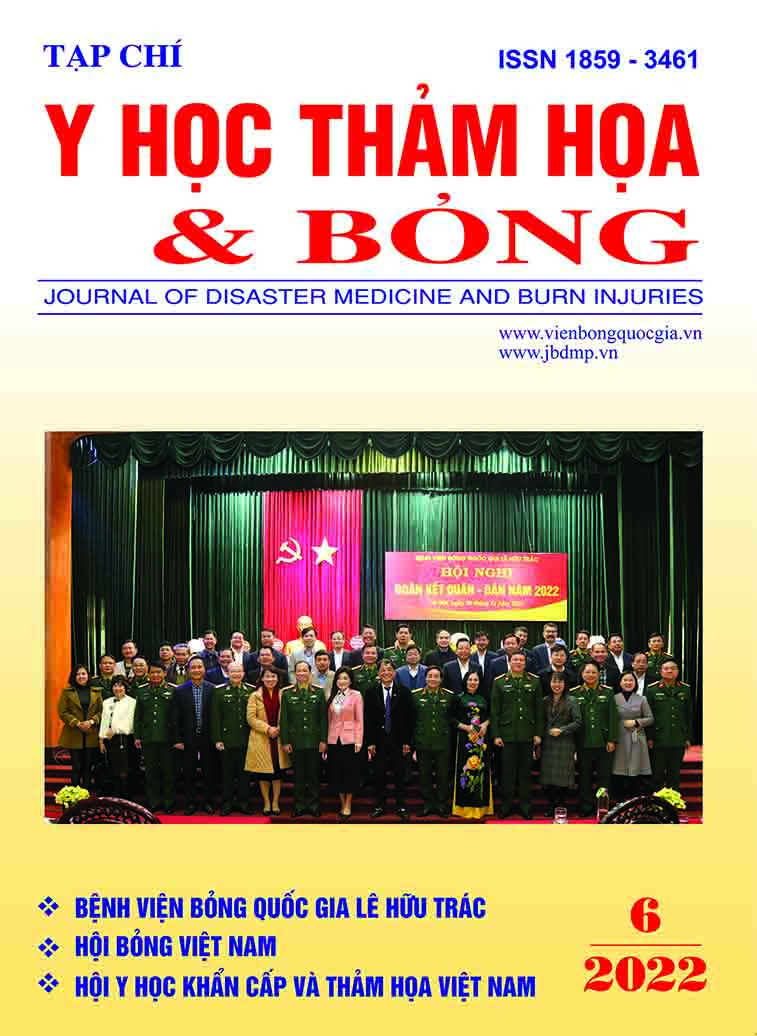Assessment of the effect of low-level laser therapy (808nm) on the proliferation and migration of fibroblasts from chronic wound tissue
Main Article Content
Abstract
Objectives: 1/To evaluate the morphology and proliferation of cultured dermal fibroblasts derived from patients with chronic wounds. 2/Evaluating the effect of low-level laser therapy (LLLT) 808nm on the proliferation and migration of fibroblasts from chronic wound tissue.
Subjects and Methods: A prospective study was conducted on 36 dermal samples from 12 patients with pressure ulcers and diabetic ulcers. Dermal samples were taken in the operating room and fibroblasts were isolated according to the procedure of Freshney RI (2003). Fibroblasts obtained in P3 generation will be cultured on 6 plates and divided into groups of laser irradiation with different energy levels and a control group (without laser). Conduct LLLT projection with energy levels of 5J; 4J; 3.5J; 3J; 2.5J and exposure times were: 60, 48, 42, 36, the 30s, respectively, for 3 consecutive days to evaluate proliferation and migration between the Laser group and the control group. Cells were counted at 24 h after the last laser exposure using the trypan blue experiment.
Results: The wound base fibroblasts (position 1) proliferated slowly, showed signs of aging, did not retain their phenotype, died floating on the surface of the culture plate, and could not trypsin to the P4 generation. Fibroblasts at positions 2, and 3 (wound margins and healing skin adjacent to the wound) could be isolated to the P3, P4, and P5 generation and did not change morphology. After LLLT irradiation, the number of cells in the laser group with energy levels: 3.5J; 3J, and 2.5J increased higher than the control group; with the highest increase at the energy level of 3J. LLLT dose of 3J with a corresponding exposure time of 36s increased the migration rate of fibroblasts when compared with the control group, completely covering the culture plate on 3rd day.
Conclusion: Fibroblasts derived from patients with pressure ulcers and diabetic ulcers can be isolated from the wound edge and healed skin adjacent to the wound without changing morphology when cultured. After LLLT irradiation (808 nm) on isolated fibroblasts, the effect was dose-dependent. The 3J dose did not change fibroblast morphology; or induce biostimulation, proliferation, and migration of cultured fibroblast samples derived from chronic wound patients.
Article Details
Keywords
Low-level laser therapy, fibroblasts, chronic wound
References
2. Addis, R., et al., Fibroblast proliferation and migration in wound healing by phytochemicals: Evidence for a novel synergic outcome. International journal of medical sciences, 2020. 17(8): p. 1030.
3. Brem, H., et al., Primary cultured fibroblasts derived from patients with chronic wounds: a methodology to produce human cell lines and test putative growth factor therapy such as GMCSF. 2008. 6(1): p. 1-9.
4. Freshney, R.I., Culture of animal cells: a manual of basic technique and specialized applications. 2015: John Wiley & Sons.
5. Kaltenbach, J., M.H. Kaltenbach, and W.J.E.C.R. Lyons, Nigrosin as a dye for differentiating live and dead ascites cells. 1958. 15(1): p. 112-117.
6. Basso, F.G., et al., In vitro wound healing improvement by low-level laser therapy application in cultured gingival fibroblasts. International journal of dentistry, 2012. 2012.
7. desJardins-Park, H.E., D.S. Foster, and M.T.J.R.m. Longaker, Fibroblasts and wound healing: an update. 2018, Future Medicine. p. 491-495.
8. Loots, M.A., et al., Cultured fibroblasts from chronic diabetic wounds on the lower extremity (non-insulin-dependent diabetes mellitus) show disturbed proliferation. 1999. 291(2): p. 93-99.
9. Vande Berg, J.S., et al., Cultured pressure ulcer fibroblasts show replicative senescence with elevated production of plasmin, plasminogen activator inhibitor‐1, and transforming growth factor‐β1. 2005. 13(1): p. 76-83.
10. Brem, H., et al., Primary cultured fibroblasts derived from patients with chronic wounds: a methodology to produce human cell lines and test putative growth factor therapy such as GMCSF. Journal of translational medicine, 2008. 6(1): p. 1-9.
11. Basso, F.G., et al., Low-level laser therapy in 3D cell culture model using gingival fibroblasts. 2016. 31(5): p. 973-978.
12. AlGhamdi, K.M., A. Kumar, and N.A.J.L.i.m.s. Moussa, Low-level laser therapy: a useful technique for enhancing the proliferation of various cultured cells. 2012. 27(1): p. 237-249.
13. Kreisler, M., et al., Low-level 809‐nm diode laser‐induced in vitro stimulation of the proliferation of human gingival fibroblasts. Lasers in Surgery and Medicine: The Official Journal of the American Society for Laser Medicine and Surgery, 2002. 30(5): p. 365-369.
14. Ma, H., et al., Effect of low-level laser therapy on proliferation and collagen synthesis of human fibroblasts in Vitro. 2018. 14(1): p. 1-6.
15. Peplow, P.V., T.-Y. Chung, and G.D. Baxter, Laser photobiomodulation of proliferation of cells in culture: a review of human and animal studies. Photomedicine and Laser Surgery, 2010. 28(S1): p. S-3-S-40.
16. Woodruff, L.D., et al., The efficacy of laser therapy in wound repair: a meta-analysis of the literature. Photomedicine and laser surgery, 2004. 22(3): p. 241-247.


